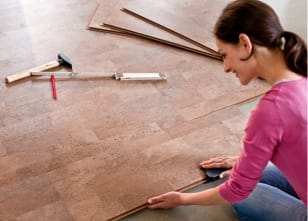Cork floors in the kitchen is one of the most cost-effective solutions in the price-performance ratio, but probably due to lack of consumer awareness, they are not popular. In this article we will talk about the advantages and disadvantages of the material, as well as how to choose the flooring with the help of 11 tips and 20 photos of cork floors in the interior.
Advantages and disadvantages
Cork floors have the following advantages:
- They are very pleasant for walking barefoot. Moreover, due to its structure consisting of a multitude of air cells, cork floors absorb each step you take. So, for those who have problems with the joints, the spine and the musculoskeletal system - it is better not to find a covering;
- They will not allow your dishes to break in the event of a fall - again due to their softness and springiness;
- The stopper helps to keep warm and remains warm even if the room is cool;
- Do not slip (however, it largely depends on the protective coating);
- Cork is easy to clean, does not absorb fat, as well as such coloring liquid products like beet juice or red wine. In addition, it does not attract dust, as it does not accumulate static electricity;
- Waterproof and not rotting, as cork contains lignin, seberin and ceroids. This means that in the case of, say, a pipe breakthrough, the floor will not deteriorate and will not be covered with mold. But, strictly speaking, serious "flooding" will withstand only glue cork floor;
- Not subject to burning. Cork can only char;
- Have a long service life. A good cork floor will last you at least 20 years in excellent condition;
- Thanks to the air cells that make up the cork, the coating has a volumetric memory. This means that neither kitchen furniture, nor fallen heavy things will not leave any dents on it. More precisely left, but over time the form will be restored;
- They muffle both air and shock noises, both from inside the room and outside;
- The price of cork floors is from 1500 rubles / sq. m - it is almost 2 times cheaper than parquet or solid wood, despite the fact that in terms of performance, cork is much better than wood.

Unfortunately, this unique material has its drawbacks:
- Although the cork is waterproof, it can still swell from prolonged exposure to moisture. Castle cork floors at the joints of dies are particularly susceptible to this. The glue floor is not afraid of water, but because of the protective 3 layers of lacquer, the floor may become as slippery as a laminate or polished solid;
- Cork is afraid of sharp objects. However, on the lacquered floor of a child’s play, a cat or knives falling, there can be only inconspicuous scratches that can be restored;
- The cost of cork is higher than laminate, tile or linoleum;
- The adhesive floor, which is most suitable for the kitchen, requires a perfectly flat base and professional, rather than self-assembly, which affects the overall price.
11 optional tips
Tip 1.Adhesive flooring is better suited for a kitchen whose owners often cook and spend time there.
The adhesive floor is good because it can be made as tight as possible - not having joints between the dies or near the walls. Due to this, it will not be damaged even due to the large volume of water and will not allow it to “flood” its neighbors from below.
Characteristics of the material - the tiles of the adhesive coating are double-layered: the bottom layer consists of a pressed cork, and the decorative layer is made of cork veneer. After laying the coating is treated with wax, oil or varnish. The tiles are available in different formats, but since their sizes are multiple to each other, you can play with the design of the masonry - lay the floor "herringbone", in the range, chess order and even zigzag as in the photo below.

Minuses: in contrast to the castle adhesive floor requires an ideal base and high-quality professional styling. In addition, it cannot be reused after dismantling.
Hint: Cork glue floor in the kitchen should be covered with 3-4 layers of varnish.
Tip 2. If you live in a rented apartment, do not cook too often and do not want to carefully level the base, then it is more profitable to buy a lock floor

Castle ("floating") floors are more suitable for decoration of little-used kitchens and canteens, as they fully withstand spilled liquids, but only up to 24 hours. But spoiled tiles are subject to replacement, and most importantly - the coating is very quickly and easily mounted independently. Even it is not necessary to apply lacquer on it, most often it is sold with factory processing. In addition, “floating” floors due to the use of the substrate (when laying) and MDF bases can be laid on the base with drops of up to 2-3 mm per 2 m, which also saves you time, effort and money. Another plus is that the lock plug can reliably imitate floor or floorboard.
Characteristics of the material: dies of the "floating" floor consist of MDF base, the middle of the pressed tube and the decorative layer of cork veneer (2-3 mm). The format, size, method of installation (on the principle of "thorn-groove"), and sometimes cork strips look like laminate.
Minuses: As already noted, castle cork coverings have a weak point - seams. If water seeps into the joints, the ends of the slats will swell, and the plug may slightly detach from the MDF plate. Another drawback is that the price for locking floors is slightly higher than for adhesive floors, and they also require the purchase of a special substrate.
Hint: In order to keep the kitchen floor at its best, choose a material with moisture-resistant ends and be sure to seal all joints with a water-repellent sealant.
Tip 3. The thicker the material, the better
- Adhesive cork cover for the kitchen should have a thickness of 6 mm, not 4 mm.
- Castle floor is 10-12 mm thick. Other things being equal, thicker material will be more reliable.
Tip 4. If you want to buy a light floor, then give preference to options with chamfer
White, beige, light gray coatings make the seams and any styling errors more noticeable. This can be avoided if you choose a floor with chamfers (bevels on the edges).
Tip 5. Do you want the floor to always appear clean? Choose a material with a characteristic pattern and texture of cork veneer
Not too light (beige, gray, brown, dark brown) tinted coatings with a characteristic "cork" texture always seem to be clean. Small crumbs, water droplets, stains and other household pollution can be noticed on them only if you look closely.

Tip 6. Tinted cork retains its original color longer than unpainted
If the kitchen comes out on the sunny side, then you should prefer tinted material, as the cork is a natural color, just coated with varnish over time, "burn out" from ultraviolet radiation.
Tip 7. Buy a cork from one party
Due to the specifics of production, cork floors from different batches differ slightly in tone and size, which becomes noticeable only during the installation process.For the same reason, we advise you to play it safe and buy tiles with a margin, especially if you buy a lock stopper.
Tip 8. Avoid solvent based adhesives.
If you decide to lay a glue floor, then pay special attention to the choice of glue. The best choice would be water-based glue, but solvent-based compounds can permanently saturate your floors with an unpleasant chemical odor. Do not be afraid of the high price of water-based adhesives, because they have 2 times more economical consumption.
Tip 9. Pay special attention to buying varnish
- Elastic varnish, as well as glue, it is better to choose water-based;
- Keep in mind that the coatings treated with lacquer with ceramic chips, although they increase the durability of the floors, are not so pleasant to walk on them, and children can erase their skin about them. And they ... may wear household socks faster;
- After varnishing the cork, wait at least a week before starting to use it - do not walk on it in shoes and do not place furniture.
Tip 10. If you want to buy cork plinth, give preference to skirting factory varnished
In terms of time, money and labor it is more profitable to buy already varnished baseboards, since non-varnished, although cheaper, will still have to be treated twice with varnish.
Tip 11. To extend the life of the coating, use special care products.
- Difficult dirt that is inevitable in the kitchen should be removed with special soft cleaners for cork floors, for example, Euku-clean.
- Every one or two years, apply special wax and paraffin-based care products to the floor. They will restore the beauty of the cork and enhance its anti-static properties.
- Every 5-10 years update the lacquer layer.
Photos of cork floors in the interior of the kitchen
And finally, we present you a selection of photos of cork floors in the interiors of kitchens in classic and modern styles. Let's start with the classics.






But the photo examples of the use of cork in the interior of modern kitchens.





- Gender is relative: choose flooring for the kitchen
- Self-leveling kitchen floor
- All about ceramic floor tiles in the kitchen
- Floorboard in the kitchen - all the pros and cons
- Everything about linoleum for the kitchen - compare, choose and lay your own hands
- Porcelain tiles in the kitchen - 99% perfect floor


